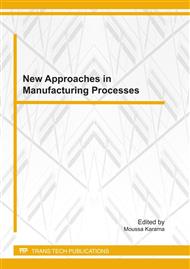[1]
S. Laporte, J. -Y. K'Nevez, O. Cahuc, P. Darnis, A parametric Model of Drill Edge Angles, Using Grinding Parameters , International Journal of Forming Processes, Vol. 10 - N° 4, (2007).
DOI: 10.3166/ijfp.10.411-428
Google Scholar
[2]
S. Laporte, J. -Y. K'Nevez, O. Cahuc, P. Darnis, Phenomenological model for drilling operation, International Journal of Advanced Manufacturing Technology, Vol. 5 - N° 1-2, pp.1-11, (2009).
DOI: 10.1007/s00170-007-1305-4
Google Scholar
[3]
J. -Y. K'Nevez, S. Laporte, O. Cahuc, P. Darnis, A multi linear cutting model for drilling tools, International Journal of Machining and Machinability of Materials, Vol. 5, N°2/3, pp.155-175, (2009).
DOI: 10.1504/ijmmm.2009.023389
Google Scholar
[4]
E. Merchant , Mechanics of the metal cutting process. I. Orthogonal cutting an type 2 chip, Journal of Applied Physics, (1945).
DOI: 10.1063/1.1707586
Google Scholar
[5]
L. B. Oxley, Modeling machining processes with a view to their optimization, Robotics and Computer Integrated Manufacturing, 103-119, (1988).
Google Scholar
[6]
M. Elhachimi, S. Torbaty and P. Joyot, Mechanical modeling of high speed drilling. 1: Predicting torque and thrust,. International Journal of Machine Tools & Manufacture. 1999a, pp.553-568, (1999).
DOI: 10.1016/s0890-6955(98)00050-9
Google Scholar
[7]
M. Elhachimi, S. Torbaty and P. Joyot, Mechanical modelling of high speed drilling. 2: Predicted and experimental results,. International Journal of Machine Tools & Manufacture. 1999b, pp.569-581, (1999).
DOI: 10.1016/s0890-6955(98)00051-0
Google Scholar
[8]
A. Yang Juhchin, Venkatraman Jaganathan , Ruxu Du , A new dynamic model or drilling and reaming processes,. International Journal of Machine Tools & Manufacture, vol. 42, pp.299-311, (2002).
DOI: 10.1016/s0890-6955(01)00102-x
Google Scholar
[9]
S. Laporte, Comportement et endommagement de l'outil en perçage à sec : application aux assemblages aéronautiques,. Thèse de doctorat de mécanique, Université Bordeaux 1, France, n°3088, (2005).
Google Scholar
[10]
Wen-Chou Chen, Kuang-Hua Fuh, Chih-Fu Wu, Biing-Rong Chang., Design optimisation of a split-point drill by force analysis,. Journal of Materials Processing Technology, Vol. 58, pp.314-322, (1996).
DOI: 10.1016/0924-0136(95)02156-6
Google Scholar
[11]
M. Shatla and T. Altan, Analytical modeling of drilling and ball end milling., journal of Materials Processing Technology, Vol. 98, pp.125-133, (2000).
DOI: 10.1016/s0924-0136(99)00313-1
Google Scholar
[12]
F. Girot et D. Géhin, Perçage à sec des alliages d'aluminium aéronautique., Mécanique et Industries, Vol. 3, pp.301-313, (2002).
DOI: 10.1016/s1296-2139(02)01170-3
Google Scholar
[13]
A. Langela, L. Nele and A. Maio, A torque and thrust prediction model for drilling of composite materials., Composites – Part A : applied science and manufacturing, Vol. Part A 36, pp.83-93, (2005).
DOI: 10.1016/s1359-835x(04)00177-0
Google Scholar
[14]
F. Dargnat, Modélisation semi-analytique par approche énergétique du procédé de perçage de matériaux monolithiques". Thèse de Doctorat de Mécanique. France, Université de Bordeaux 1. N° d, ordre : 3216, (2006).
Google Scholar
[15]
F. Dargnat, Ph. Darnis, O. Cahuc, Analytical modelling of cutting phenomena improvements with a view to drilling modeling, Int. J. Machining and Machinability of Materials, Vol. 5, Nos. 2/3, pp.176-206, (2009).
DOI: 10.1504/ijmmm.2009.023390
Google Scholar


